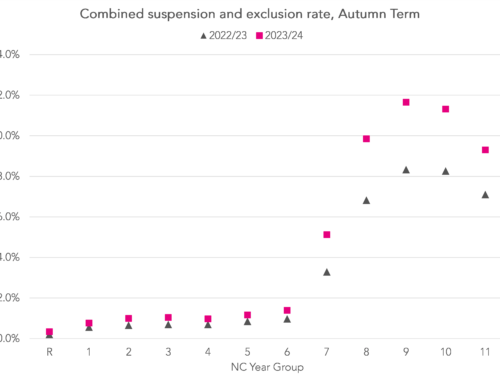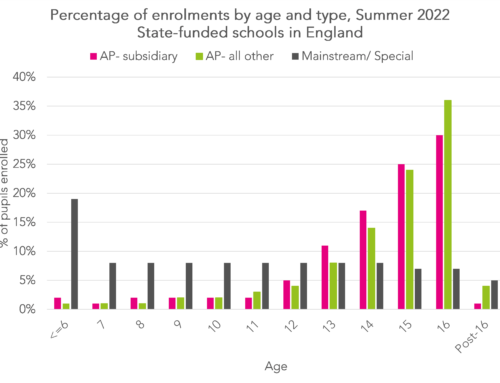A blog I wrote last week, on the “UKIP voters of tomorrow”, was very popular. In it, I explored the relationship between UKIP vote share in the 2015 General Election and constituency average GCSE performance between 2011 and 2014. There seemed to be a negative relationship between the two measures – constituencies with higher UKIP vote shares tended to have lower GCSE performance.

Many readers found this to be surprising and interesting. Some, however, rightly commented that the observed relationship could be down to other factors and that more analysis was needed. A few went further, declaring that the correlation (-0.34) was too weak and should be considered spurious. Were they right?
There are a number of factors that could explain away the relationship between UKIP vote share and GCSE performance. One is the education level of voters. Ford and Goodwin found that UKIP voters were more likely have low educational qualifications. Plenty of sociological and economic research shows strong connections between parents’ education levels and that of their children’s (there is a good summary of the literature here). It seems plausible then that constituencies with higher proportions of adults with low education would have both higher UKIP vote shares and lower GCSE performance. Levels of unemployment in the constituency might be another explanation for the relationship, as might the ethnic composition. People living in areas with higher unemployment might be more likely to vote for UKIP as a reaction to poor economic conditions, whilst school pupils might be less motivated to do well in school if there aren’t as many jobs available. Similarly, research suggests that children from some ethnic minority groups out-perform their White British peers, so greater proportions of White British pupils might well be associated with lower school performance. At the same time, UKIP’s stance on immigration means that areas with higher ethnic minority proportions are likely to have lower UKIP vote shares. Finally, higher levels of deprivation in an area could both drive people to vote for UKIP and lead to children’s educational underachievement (the impact of poverty on education is quickly summarised here).
When all these factors (plus the average age of people) are modelled together in a robust regression (to help deal with a few outlier constituencies), we get the results seen in the figure below.

Each point on the figure is an estimate of the size of the effect of a particular constituency-level characteristic on UKIP vote share. The error bars show 95% confidence intervals, and the effects have been standardised so they can be compared easily.
Firstly, the model now explains 51% of the variance, which is a decent improvement on the 12% explained earlier. Secondly, all variables in the model are highly significant (p <0.01) except for mean age of people in the constituency, which is not significantly associated with UKIP vote share at all. Thirdly, and crucially, average GCSE performance is still significant even in the presence of the other relevant constituency-level factors. This means that average GCSE performance is still negatively associated with UKIP vote share – constituencies with better GCSE performance have lower UKIP vote shares even after accounting for local levels of education, unemployment, deprivation and ethnicity. However, the size of the effect is small at -0.09. To put that into context, this means that as average GCSE performance increases by 7.5 percentage points (a one standard deviation increase), UKIP vote share decreases by 0.5 percentage points, holding all other effects constant.
Fourthly, the effects of all the other significant variables are much larger, especially the percentage of people with no qualifications in the area (+0.47) and the percentage of non-White British people (-0.48). Increasing the proportion of people with no qualifications by 6.1 percentage points (one standard deviation) increases the UKIP vote share by 2.7 percentage points, holding all other effects constant. Conversely, a 19.2 percentage point (one standard deviation) increase in the share of non-White British people in a constituency reduces UKIP vote share by 2.7 percentage points, holding all other effects constant. Of course, these factors may have non-linear effects, and may interact with each other to produce more complex effects, but for the sake of simplicity, these are not explored here.
So what can we conclude from this? The finding that average GCSE performance is significantly associated with UKIP vote share, even after accounting for other constituency-level factors, suggests that the argument made in my first blog was not a false one. The evidence presented here indicates that low educational performance is significantly associated with higher UKIP vote shares, both in terms of proportions of adults with no qualifications and in terms of poorer GCSE performance in local schools. Although proportions of ethnic minority students are likely to contribute to improved school outcomes, the relevance of adult educational background in this analysis suggests that our strategies to improve educational outcomes for children might need to be re-examined. Rather than providing extra funding and support only for children with low-income backgrounds, we could consider also providing extra resources for children from low educational backgrounds. Given the link between parental education background and children’s educational outcomes, targeting extra support at those who are most educationally disadvantaged might be the best way to help the UKIP voters of tomorrow.






Leave A Comment